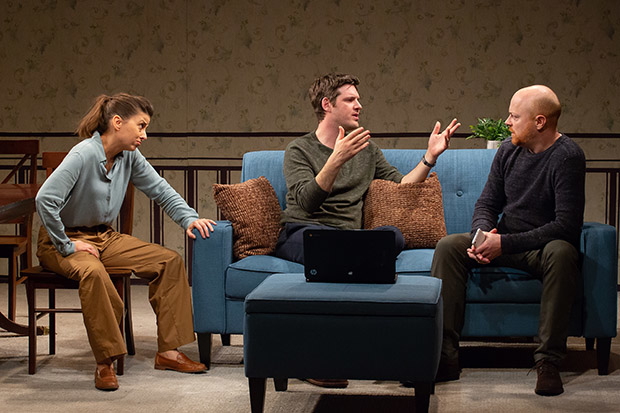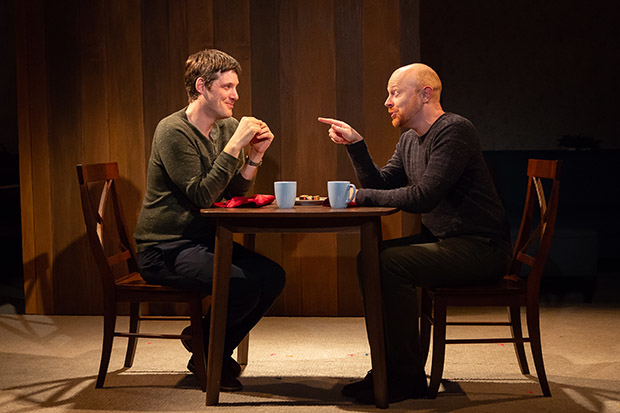Three Performers Take On a Six-Character Play in Catch as Catch Can

(© Hunter Canning)
Three of the most daring performances in New York are currently taking place at the New Ohio Theatre. That's where Jeff Biehl, Michael Esper, and Jeanine Serralles are currently starring in Mia Chung's Catch as Catch Can, now receiving its world premiere from Page 73. The three actors play two roles each, with those characters sometimes appearing in the same scenes. This results in breakneck, yet shockingly lucid performances. It's a shame they aren't in a better play.
The problems with Catch as Catch Can are apparent from the first scene, which takes place over tea and rainbow cookies between longtime friends Roberta (Biehl) and Theresa (Esper). Both New Englanders, they gab about work, kids, and the royal wedding. This chat-and-chew serves as particularly saggy, talky exposition as we learn that Theresa's son, Tim (also Esper), is engaged to a Korea-American woman he met in California, where he has lived for the past 11 years. Adopting an immediate stank face, Roberta remembers Cindy, the Korean ex-wife of her son, Robbie (also Biehl). Theresa wonders what the chances are that both of their sons would marry Asian women. "They'll definitely talk," Roberta says somewhat incredulously.

(© Hunter Canning)
We go on to meet Roberta's husband, Lon (Serralles), and her daughter, Daniela (also Serralles), both of whom arrive in their own scenes of extended exposition. We sense some romantic tension between Daniela and Tim, while the inscrutable Robbie seems to carry a cloud around him. We discover the central conflict of the play just as the first act is ending. Catch as Catch Can is an exceedingly slow boil, which can be a satisfying theatrical experience if we feel like there's a payoff. Sadly, this play builds to a combustible first-act finale, only to fizzle in the second.
Chung has created a sensitive and detailed portrait of two families that have become like one, and how the challenges of mental illness threaten to break that bond. Unfortunately, seeing the roundabout way she gets at that story is about as thrilling as watching paint dry.
The doubling of the roles offers the opportunity for some theatrical excitement, and the actors seize it. Esper impressively performs a scene between Tim and Theresa that is heavy with emotional subtext. Both feet firmly planted on the floor, he manages to make each shift between characters perfectly clear. Serralles is similarly coherent in a one-woman montage of frustrating conversations with doctors and medical staff. Biehl walks the thin line between masculinity and femininity with his scowling portrayal of Roberta and his poker-faced interpretation of Robbie. Freudian tropes aside, the significance of the doubled roles is never fully apparent, which makes it seem like little more than a theatrical gimmick.

(© Hunter Canning)
At least that gimmick is impressively executed by director Ken Rus Schmoll. The well-choreographed chaos of the Christmas-party scene, in which every character makes an appearance, is a wonder to behold. The cheap beige carpet and retro-'70s wood paneling of Arnulfo Maldonado's set gives us a general sense of working-class New England, while sliding walls provide for a variety of locations. The set still offers surprises well into the second act. Maldonado's versatile costumes feature muted colors and ambiguous cuts, so that they seem to belong to both characters. Jiyoun Chang's targeted lighting and Brendan Aanes well-selected sound design help to make these transformations specific so that we immediately know what we're looking at. Schmoll (who has previously helmed Judy and Grounded for Page 73) once again marries evocative design with less-is-more performances. Unfortunately, that still cannot save the script from its inherent dullness.
After two hours and 10 minutes, Catch as Catch Can seems to abruptly end, with some matters resolved and others frustratingly inconclusive. While this may be an accurate representation of life, it makes for confusing and inert theater — a fact betrayed by the hesitant applause of the audience at the performance I attended, as we sat in the dark and wondered if it was over yet.










